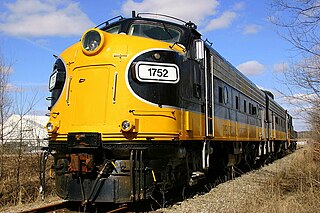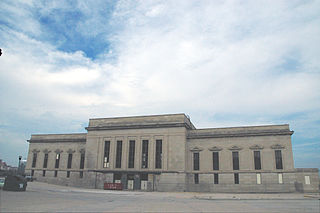Related Research Articles

The BNSF Railway Company is the largest freight railroad network in North America. One of seven North American Class I railroads, BNSF has 42,000 employees, 32,500 miles (52,300 km) of track in 28 states, and more than 8,000 locomotives. It has three transcontinental routes that provide rail connections between the western and eastern United States. BNSF trains traveled over 169 million miles in 2010, more than any other North American railroad.

The Chicago, Burlington and Quincy Railroad was a railroad that operated in the Midwestern United States. Commonly referred to as the Burlington Route, the Burlington, or as the Q, it operated extensive trackage in the states of Colorado, Illinois, Iowa, Kansas, Kentucky, Missouri, Montana, Nebraska, Wisconsin, Wyoming, and also in New Mexico and Texas through subsidiaries Colorado and Southern Railway, Fort Worth and Denver Railway, and Burlington-Rock Island Railroad. Its primary connections included Chicago, Minneapolis–Saint Paul, St. Louis, Kansas City, and Denver. Because of this extensive trackage in the midwest and mountain states, the railroad used the advertising slogans "Everywhere West", "Way of the Zephyrs", and "The Way West".

The Arkansas, Louisiana and Mississippi Railroad is a 52.9-mile (85.1 km) short-line railroad in northern Louisiana and southern Arkansas. Opened in 1908, it has undergone several corporate reorganizations, but has remained independent of larger carriers. In 2004, paper producer Georgia-Pacific sold the company to shortline operator Genesee & Wyoming Inc. Traffic generally consists of lumber, paper, forest products, and chemicals.

Forgottonia, also spelled Forgotonia, is the name given to a 16-county region in Western Illinois in the late 1960s and early 1970s. This geographic region forms the distinctive western bulge of Illinois that is roughly equivalent to "The Tract", the Illinois portion of the Military Tract of 1812, along and west of the Fourth Principal Meridian. Since this wedge-shaped region lies between the Illinois and Mississippi rivers, it has historically been isolated from the eastern portion of Central Illinois.

The Burlington and Missouri River Railroad (B&MR) was an American railroad company incorporated in Iowa in 1852, with headquarters in Omaha, Nebraska. It was developed to build a railroad across the state of Iowa and began operations in 1856. It was acquired by the Chicago, Burlington and Quincy Railroad in 1872, and kept serving as its subsidiary.

The Keokuk Junction Railway Co., is a Class III railroad in the U.S. states of Illinois and Iowa. It is a subsidiary of Pioneer Railcorp.

The Kansas City Terminal Railway is a Class III terminal railroad that serves as a joint operation of the trunk railroads that serve the Kansas City metropolitan area, the United States' second largest rail hub. It is operated by the Kaw River Railroad.
The Deadwood Central Railroad (DCRX) was a 3 ft narrow gauge railroad in the U.S. state of South Dakota. It was founded by Deadwood, South Dakota resident J.K.P. Miller and his associates in 1888 to serve their mining enterprises in the Black Hills. In 1928, the railroad stretched for a total length of 15.781 miles (25.397 km).

Railroads in Omaha, Nebraska, have been integral to the growth and development of the city, the state of Nebraska, the Western United States and the entire United States. The convergence of many railroad forces upon the city was by happenstance and synergy, as none of the Omaha leaders had a comprehensive strategy for bringing railroads to the city.
The Humeston and Shenandoah Railway was part of a collection of railroad lines built as a westward extension to the Missouri, Iowa and Nebraska Railway across southern Iowa, USA, in the last half of the 19th century. These lines were later exclusively operated, during the 20th century, by the Burlington Route. The Humeston and Shenandoah was originally envisioned as part of a strategy to allow Jay Gould and his Wabash Railroad to reach Omaha, Nebraska. The line's construction was contested, however, by the Burlington Route, and eventually Gould compromised and allowed the H&S Railroad to be built as a joint initiative with the Burlington. Upon completion of construction, the H&S line was leased for operation to a company owned jointly by the Wabash and the Burlington on April 1, 1881, and operated for their joint accounts. This arrangement continued until the Wabash bankruptcy of 1899, after which the line was operated by the Burlington Route under lease.
The Minnesota Transfer Railway was a short line railroad in the United States. It was incorporated on March 22, 1883.
The following is a brief history of the North American rail system, mainly through major changes to Class I railroads, the largest class by operating revenue.
The Chicago and Illinois River Railroad was a predecessor of the Alton Railroad that built a line from Joliet southwest through Coal City, Illinois, to the Mazon River. A portion is now a second main track on the BNSF Railway's Southern Transcon.

The Wabash Railroad was a Class I railroad that operated in the mid-central United States. It served a large area, including track in the states of Ohio, Indiana, Illinois, Iowa, Michigan, and Missouri and the province of Ontario. Its primary connections included Chicago, Illinois; Kansas City, Missouri; Detroit, Michigan; Buffalo, New York; St. Louis, Missouri; and Toledo, Ohio.
The Iowa and St. Louis Railway (I&SL) was a subsidiary United States railroad operating in south-east Iowa and north-east Missouri from 1902 to 1947. For most of its existence it was part of the Chicago, Burlington and Quincy Railroad (CBQ), familiarly known as the Burlington System.
The Black Hills and Fort Pierre Railroad (BH&FP) was a 3 ft narrow gauge railroad in the Black Hills of the U.S. state of South Dakota. It was created by the Homestake Mining Company and initially ran from Lead to Calcite and Piedmont by way of Elk Creek. An alternate route was established to Piedmont and Calcite by way of Nemo and Stagebarn Canyon after numerous washouts made the Elk Creek route unviable. There was also a branch from the Nemo line connecting Este with a logging camp at Merritt. The railroad had 6.180 miles (9.946 km) of dual gauge track and another 47.618 miles (76.634 km) of 3 ft track; the total amount of track was 53.798 miles (86.579 km).
The Grand Island and Wyoming Central Railroad (GI&WC) was a railroad that served the U.S. states of Nebraska and South Dakota. It was headquartered in Grand Island, Nebraska. In 1902, it had a length of 401.32 miles (645.86 km).

Keokuk Union Depot is an historic train station on the west bank of the Mississippi River near downtown Keokuk, Iowa, United States. It was built from 1890 to 1891, and it was listed on the National Register of Historic Places in 2013.

Missouri, Iowa & Nebraska Railway Co. Depot-Weldon, also known as Weldon Depot, is a historic structure located in Weldon, Iowa, United States. The Missouri, Iowa, and Nebraska Railway Company (MI&N) was established in 1870 with the merger of the Alexandria and Nebraska City Railroad Company and the Iowa Southern Railway under the direction of Francis M. Drake. The MI&N decided to extend the line from Corydon, Iowa to Van Wert. J.P. Kline sold the railroad 70 acres (28 ha) of farmland on which the town of Weldon was founded. The railroad began construction of the Weldon Depot in 1880, the same year the town was laid out. The depot was completed the following year. The MI&N was reorganized in 1886 as the Keokuk & Western Railroad. They operated the rail line through Weldon until 1901 when it became part of the Chicago, Burlington & Quincy Railroad. Passenger service continued in Weldon until December 1945. The last freight train went through the station in January 1946. The tracks were torn out when the railroad ceased service on the line. The depot was given to the town of Weldon, which maintains it. It was added to the National Register of Historic Places in 1991.
The American Central Railway was originally named the Western Air Line Railroad. The American Central Railway was incorporated on February 21, 1859, as a name change of the Western Air Line Railroad. The Western Airline had not laid any track prior to 1859. In 1868, work was started on a 50.59 mile line from Galva, Illinois to New Boston, Illinois. Work was completed in October 1869.
References
- Notes
- ↑ Formally, the railroad was authorized to begin its line at any point it chose within 18 miles (29 km) of the mouth of the Des Moines River. The line was to run westerly toward the Missouri River, never straying more than 30 miles (48 km) from the northern border of Missouri. The western terminus was to be on the Missouri River, at any point not nearer than 15 miles (24 km) nor more than 30 miles (48 km) from the state's northern border. [6]
- ↑ It retained its headquarters in Canton. [16]
- ↑ Wharves could also be constructed there, under the same logic and law. But a private warehouse could not, and the Supreme Court ordered it removed. [23]
- Citations
- 1 2 3 4 5 6 7 8 Interstate Commerce Commission 1928, p. 129.
- ↑ "Jefferson City Correspondence". Glasgow Weekly Times. January 20, 1853. p. 2. Retrieved March 23, 2017.
- ↑ Interstate Commerce Commission 1928, p. 472.
- 1 2 3 Interstate Commerce Commission 1928, p. 471.
- ↑ "Mississippi and Missouri River Air Line Railroad". American Railroad Journal. July 21, 1860. p. 638. Retrieved March 23, 2017.
- ↑ Chicago, Burlington & Quincy Railroad Company 1913, p. 272.
- ↑ Chicago, Burlington & Quincy Railroad Company 1913, p. 274.
- ↑ Interstate Commerce Commission 1928, pp. 470-471.
- ↑ Chicago, Burlington & Quincy Railroad Company 1913, p. 275.
- 1 2 Interstate Commerce Commission 1928, p. 470.
- 1 2 Missouri Railroad Commission 1881, p. 32.
- ↑ Chicago, Burlington & Quincy Railroad Company 1913, p. 277.
- 1 2 3 4 Interstate Commerce Commission 1928, p. 469.
- 1 2 Chicago, Burlington & Quincy Railroad Company 1913, p. 278.
- ↑ Chicago, Burlington & Quincy Railroad Company 1913, pp. 277-278.
- 1 2 American Railway and Supply Directory 1874, p. 251.
- ↑ Chicago, Burlington & Quincy Railroad Company 1913, p. 280.
- ↑ Chicago, Burlington & Quincy Railroad Company 1913, pp. 280-281.
- ↑ "Railroad News". The Railroad Gazette. July 3, 1875. p. 278. Retrieved January 31, 2016.
- ↑ Interstate Commerce Commission 1928, p. 465.
- ↑ Mississippi Valley and Western Railway Co. v. United States Express Co.,81IL534(Ill.1876).
- ↑ Barney v. Keokuk,94U.S.324(Sup.Ct.1876).
- 1 2 Farnham 2006, pp. 667-668.